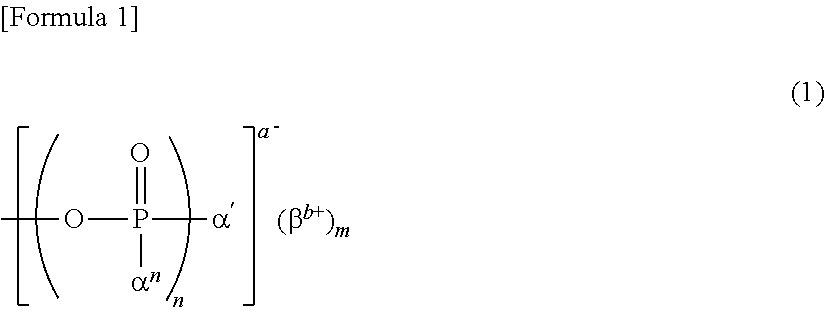Method for producing fibrous cellulose, and fibrous cellulose
a technology of fibrous cellulose and fibrous cellulose, which is applied in the field of producing ultrafine fibrous cellulose and ultrafine fibrous cellulose, can solve the problems of requiring enormous energy to obtain ultrafine fibrous cellulose, and achieve the effect of high viscosity and efficient production
- Summary
- Abstract
- Description
- Claims
- Application Information
AI Technical Summary
Benefits of technology
Problems solved by technology
Method used
Image
Examples
example 1
[0162]As a leaf bleached kraft pulp serving as a raw material, a pulp manufactured by Oji Paper Co., Ltd. (sheet-like pulp having a solid content of 93% and a basis weight of 208 g / m2, and a Canadian standard freeness (CSF) measured according to JIS P8121 after disintegration of 700 ml) was used. A mixed aqueous solution of ammonium dihydrogen phosphate and urea was added to 100 parts by weight of the above-described leaf bleached kraft pulp (absolute dry mass), and the resultant mixture was pressed to 48 parts by mass of ammonium dihydrogen phosphate, 130 parts by mass of urea and 165 parts by mass of ion exchange water, so as to obtain a chemical-impregnated pulp. The obtained chemical-impregnated pulp was dried and heat-treated for 200 seconds in a hot air dryer at 165° C. to introduce phosphoric acid groups into the cellulose in the pulp, so as to obtain phosphorylated cellulose fibers A.
[0163]Ion exchange water was poured onto the obtained phosphorylated cellulose fibers A, whi...
example 2
[0172]As a leaf bleached kraft pulp serving as a raw material, a pulp manufactured by Oji Paper Co., Ltd. (sheet-like pulp having a solid content of 93% and a basis weight of 208 g / m2, and a Canadian standard freeness (CSF) measured according to JIS P8121 after disintegration of 700 ml) was used. A mixed aqueous solution of ammonium dihydrogen phosphate and urea was added to 100 parts by weight of the above-described leaf bleached kraft pulp (absolute dry mass), and the resultant mixture was pressed to 56 parts by mass of ammonium dihydrogen phosphate, 150 parts by mass of urea and 165 parts by mass of ion exchange water, so as to obtain a chemical-impregnated pulp. The obtained chemical-impregnated pulp was heated in a hot air dryer at 105° C., so that water was evaporated to carry out pre-drying. Thereafter, the chemical-impregnated pulp was dried and heat-treated for 30 minutes in a hot air dryer at 140° C. to introduce phosphoric acid groups into the cellulose in the pulp, so as...
example 3
[0175]Cros slink-broken phosphorylated cellulose fibers, ultrafine fibrous cellulose-containing slurry, and an ultrafine fibrous cellulose-containing sheet were obtained in the same manner as that of Example 1, with the exception that the pH of the pulp slurry was adjusted to be pH 10 in the of Example 1. With regard to the ultrafine fibrous cellulose-containing slurry, supernatant yield, haze, viscosity, the amount of urethane bonds, and the content of crosslinked structures were measured according to the after-mentioned methods. With regard to the ultrafine fibrous cellulose-containing sheet, tensile strength and YI values before and after heating were measured according to the after-mentioned methods.
PUM
| Property | Measurement | Unit |
|---|---|---|
| Temperature | aaaaa | aaaaa |
| Temperature | aaaaa | aaaaa |
| Time | aaaaa | aaaaa |
Abstract
Description
Claims
Application Information
 Login to View More
Login to View More - R&D
- Intellectual Property
- Life Sciences
- Materials
- Tech Scout
- Unparalleled Data Quality
- Higher Quality Content
- 60% Fewer Hallucinations
Browse by: Latest US Patents, China's latest patents, Technical Efficacy Thesaurus, Application Domain, Technology Topic, Popular Technical Reports.
© 2025 PatSnap. All rights reserved.Legal|Privacy policy|Modern Slavery Act Transparency Statement|Sitemap|About US| Contact US: help@patsnap.com



